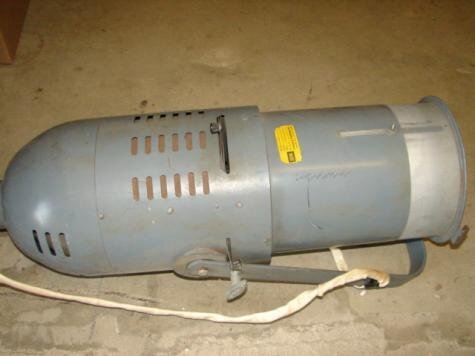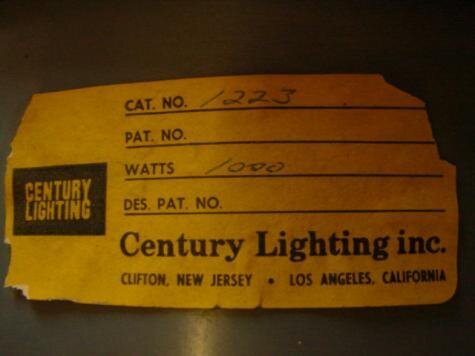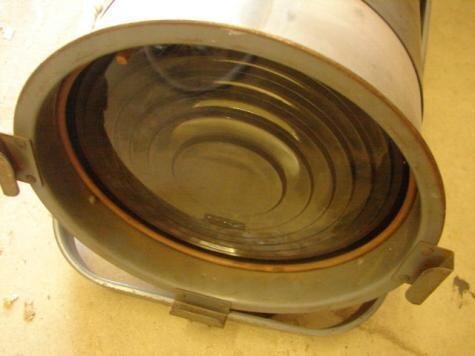I recently acquired this:
 ,
,
which is a more complete fixture than one I already had (eBay purchase: $65+$30 shipping!).
It looks identical to an EC 3366:
 ,
,
The Electro Controls Archive: Lighting Fixtures
except that it features a "screw-feed focus," like the 3365 model:
 .
.
Here's a close-up of the lens focus mechanism, without the cover:
 .
.
What is the model number for my fixtures? The only sticker on the yoke says "UL Listed, 435 J, Stage Type Fixture" (in a search, another CB member stated his Parellipshere had an identical sticker, so "435 J" must be a UL number). Wait, there's another that says "Union Made, H50605424". The one on the other says "H16013844" so that might be a serial number, but if so, why are they so far apart?
A couple of observations about these fixtures.
They're ridiculously heavy, with c-clamp (says Kliegl, go figure!) about 29 pounds. It's 27" high without clamp, standing up. Speaking of standing up, the focus knob on the front prevents the fixture from standing on its colorframe holder. And speaking of the colorframe holder, it's hinged on the bottom and held closed with a "luggage catch" on top. I have to do some investigating to see how the lens train is supposed to be retained, because right now it's being held in with friction, and I've already dropped the lenses out when the gelframe door popped open unexpectedly. Until I figure that out, this fixture cannot go in the air. The other fixture seems to have its lens carriage rusted in place.
With a fixture this big, the 42" whip is a plus, but the cut sheet says "...42" extra flexible asbestos cable." My fixture has a fiberglass sleeve, so it might be a later version, or the cut sheet is wrong, or has been replaced, but it doesn't look like it.
The cut sheet for the #3366 has a date of March, 1971. This fixture uses an EGE/EGG/EGJ -type lamp mounted axially, and thus must be one of the first axial ERSs. Relamping is quite clever. Open the rear door (another luggage catch), loosen a thumb screw and the socket pulls out. Relamp, reinsert socket, and bench focus with the door open. A knob on the bottom rear of the fixture moves the lamp in and out of the reflector, providing for peak-cosine adjustment:
 .
.
However, even when tuned well, the beam emitted is not pretty by today's standards. I suspect this is primarily due to the reflector not being faceted, but instead is a true half-ellipsoid.
Interestingly, neither of my units, nor the 3-5 others at the theatre, have a top shutter. I haven't yet investigated removing/inserting these, but upon first glance, they seem difficult to remove. EDIT: Aha! The cut sheets says "The top framing shutter is removable to allow the insertion of patterns." Chances are these were removed and immediately lost forever. I wonder what kind of pattern holder it takes?
EDIT: Stupid me! I should have looked more carefully at the big red and silver sticker on the back of the unit. It's a model 3366F. The "F" denoting the screw-feed focus, of course. Or perhaps not. The F suffix may just mean framing shutters:
 .
.
Anyone have more insights into this, somewhat unusual, fixture?
Anyone else find it odd that the little Electro Controls company was innovating fixtures (with many failures and few successes) more than industry leaders Kliegl and Century-Strand during the early 1970s?
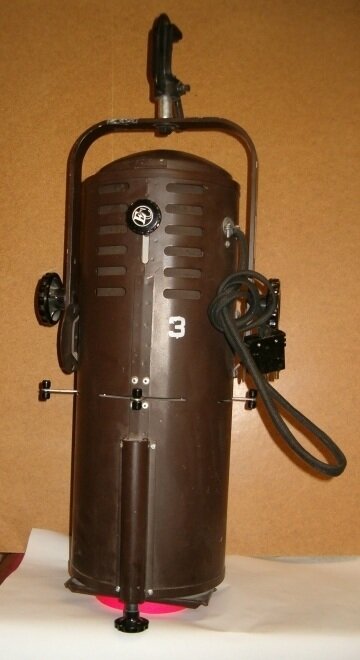 ,
,which is a more complete fixture than one I already had (eBay purchase: $65+$30 shipping!).
It looks identical to an EC 3366:
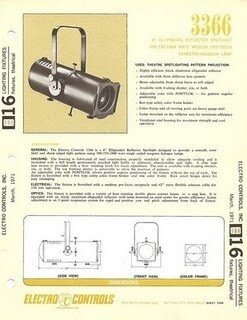 ,
,The Electro Controls Archive: Lighting Fixtures
except that it features a "screw-feed focus," like the 3365 model:
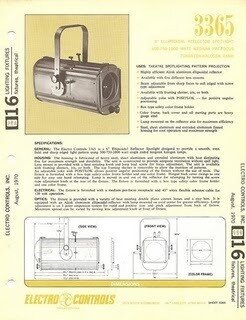 .
.Here's a close-up of the lens focus mechanism, without the cover:
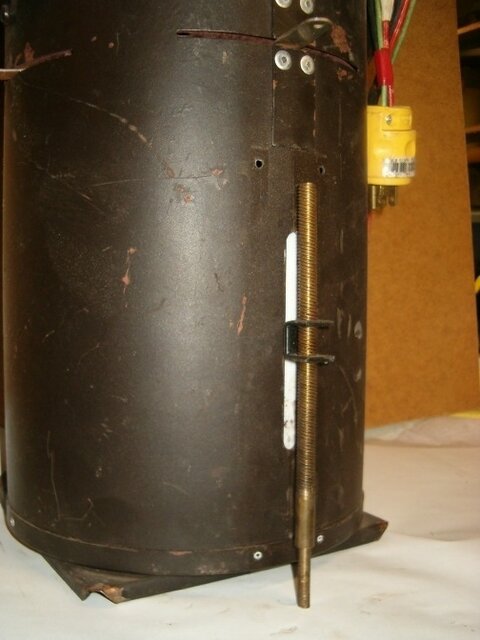 .
.What is the model number for my fixtures? The only sticker on the yoke says "UL Listed, 435 J, Stage Type Fixture" (in a search, another CB member stated his Parellipshere had an identical sticker, so "435 J" must be a UL number). Wait, there's another that says "Union Made, H50605424". The one on the other says "H16013844" so that might be a serial number, but if so, why are they so far apart?
A couple of observations about these fixtures.
They're ridiculously heavy, with c-clamp (says Kliegl, go figure!) about 29 pounds. It's 27" high without clamp, standing up. Speaking of standing up, the focus knob on the front prevents the fixture from standing on its colorframe holder. And speaking of the colorframe holder, it's hinged on the bottom and held closed with a "luggage catch" on top. I have to do some investigating to see how the lens train is supposed to be retained, because right now it's being held in with friction, and I've already dropped the lenses out when the gelframe door popped open unexpectedly. Until I figure that out, this fixture cannot go in the air. The other fixture seems to have its lens carriage rusted in place.
With a fixture this big, the 42" whip is a plus, but the cut sheet says "...42" extra flexible asbestos cable." My fixture has a fiberglass sleeve, so it might be a later version, or the cut sheet is wrong, or has been replaced, but it doesn't look like it.
The cut sheet for the #3366 has a date of March, 1971. This fixture uses an EGE/EGG/EGJ -type lamp mounted axially, and thus must be one of the first axial ERSs. Relamping is quite clever. Open the rear door (another luggage catch), loosen a thumb screw and the socket pulls out. Relamp, reinsert socket, and bench focus with the door open. A knob on the bottom rear of the fixture moves the lamp in and out of the reflector, providing for peak-cosine adjustment:
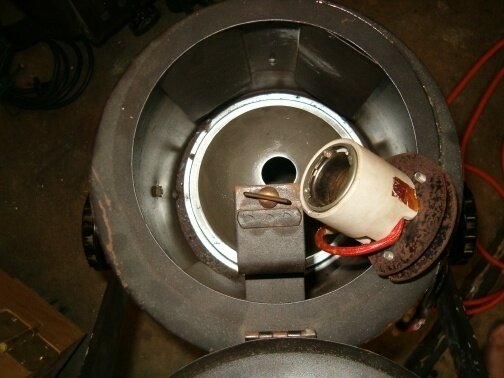 .
.However, even when tuned well, the beam emitted is not pretty by today's standards. I suspect this is primarily due to the reflector not being faceted, but instead is a true half-ellipsoid.
Interestingly, neither of my units, nor the 3-5 others at the theatre, have a top shutter. I haven't yet investigated removing/inserting these, but upon first glance, they seem difficult to remove. EDIT: Aha! The cut sheets says "The top framing shutter is removable to allow the insertion of patterns." Chances are these were removed and immediately lost forever. I wonder what kind of pattern holder it takes?
EDIT: Stupid me! I should have looked more carefully at the big red and silver sticker on the back of the unit. It's a model 3366F. The "F" denoting the screw-feed focus, of course. Or perhaps not. The F suffix may just mean framing shutters:
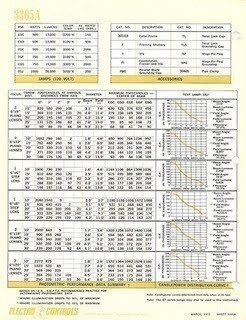 .
.Anyone have more insights into this, somewhat unusual, fixture?
Anyone else find it odd that the little Electro Controls company was innovating fixtures (with many failures and few successes) more than industry leaders Kliegl and Century-Strand during the early 1970s?
Last edited:



